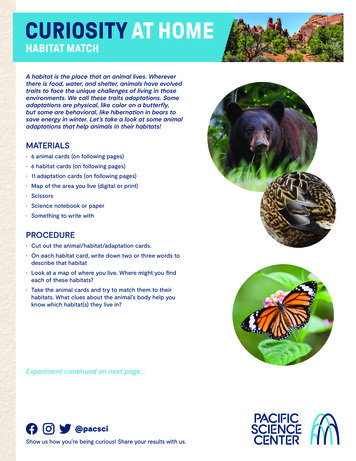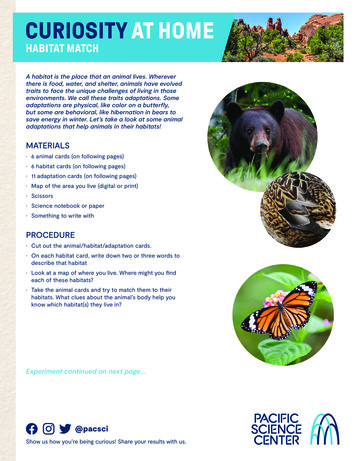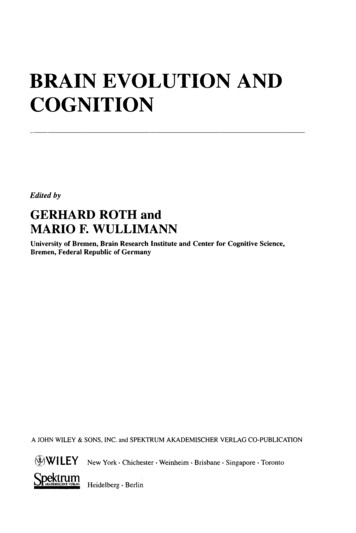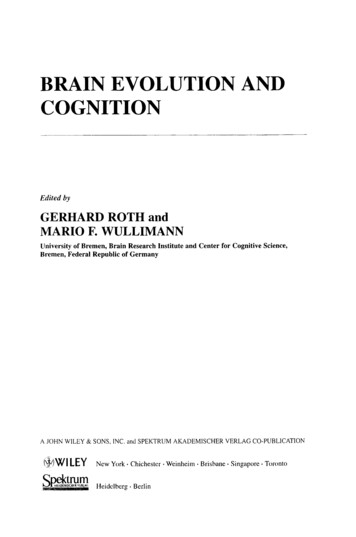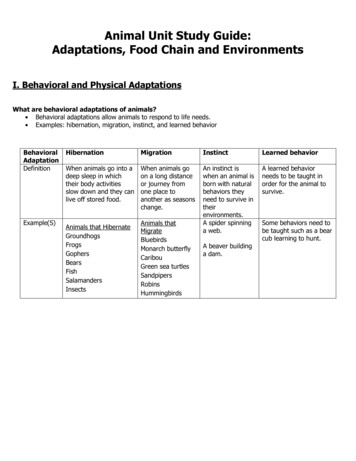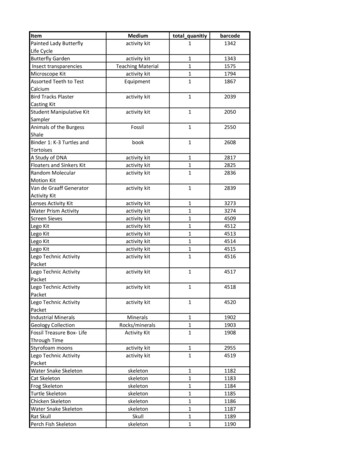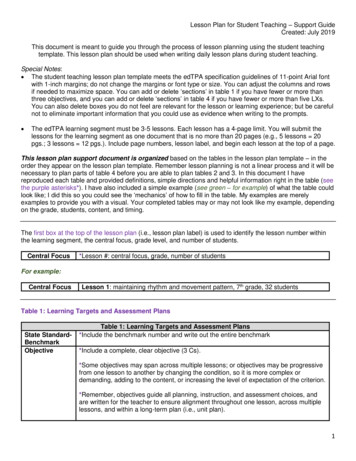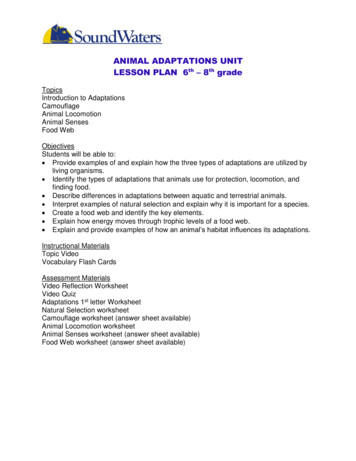
Transcription
ANIMAL ADAPTATIONS UNITLESSON PLAN 6th – 8th gradeTopicsIntroduction to AdaptationsCamouflageAnimal LocomotionAnimal SensesFood WebObjectivesStudents will be able to: Provide examples of and explain how the three types of adaptations are utilized byliving organisms. Identify the types of adaptations that animals use for protection, locomotion, andfinding food. Describe differences in adaptations between aquatic and terrestrial animals. Interpret examples of natural selection and explain why it is important for a species. Create a food web and identify the key elements. Explain how energy moves through trophic levels of a food web. Explain and provide examples of how an animal’s habitat influences its adaptations.Instructional MaterialsTopic VideoVocabulary Flash CardsAssessment MaterialsVideo Reflection WorksheetVideo QuizAdaptations 1st letter WorksheetNatural Selection worksheetCamouflage worksheet (answer sheet available)Animal Locomotion worksheetAnimal Senses worksheet (answer sheet available)Food Web worksheet (answer sheet available)
Related MaterialsLinks to videos and reading material that provides additional information on topics.NOAA ResourcesThe National Oceanic and Atmospheric Administration (NOAA) is a partner ofSoundWaters. These are additional resources you may use in addition to the othermaterials included above.Aquatic food websHorseshoe l-moon-horseshoecrab.htmlInvertebrate ebratesPlankton in the arctichttps://oceantoday.noaa.gov/animalsoftheice krill/Invent an ns/gal gr5 6 l3.pdfNGSS StandardsMatter and Energy in Organisms and Ecosystems: MS-LS2-2Natural Selection and Adaptations: MS-LS4-4
Zebras travel in herds so they use disruptive coloration so a lion cannot tell the difference between them. Lions use concealingcoloration to blend in and make it easier to hide from their preySpider crabs do not move very fast so they use both concealing and disguise to look like a rock so the seagull cannot locate them.Sharks use concealing, which is a type of concealing coloration. This breaks up their shape for when they are hunting seals.
ExampleBottom is often dark - less likely to be visual for most animalsInstead other senses are heightened to make up for itExample answers, could be othersWide open area to observeMechanoreceptors (lateral line),Chemoreceptors (smelling organisms around)Auditory (echolocation)Answers varyAnswers vary, some examples are.Other senses are heightened to make up for it. They may also have specialized body parts that help with smell, taste, hearing, ortouch that differs from animals that can see. It may develop other defenses to protect it (sea anemone)
NATURAL SELECTIONWhat is natural selection? Give an example (not a giraffe) and explain.ABCThe three pictures above demonstrate natural selection. Explain what is happening in pictures A, B, and C andhow they relate to natural selection.Name:
TYPES OF CAMOUFLAGEAn animal’s behaviors affect what type of camouflage is best for them. Select a pair of animals below andexplain what type of camouflage is used by the predator/prey based on their behaviors.Zebra and lion; seagull and spider crab; shark and seal;In the video, we discussed 3 types of camouflage. If you could have any of these types of camouflage, whichwould it be? Make sure to explain how your type of camouflage would affect your choice and habitat and whatfood you eat.Name:
ANIMAL LOCOMOTIONThe way animals move isbased on their specific bodyparts.For example, humans havelong jointed legs that allowus to walk and run indifferent directions.Column AColumn BOctopusInvertebrate, can move its arms freely to change its shapeLobsterLegs for walking surrounded by hard shell, tail to swim backwardsFlounderTail like a paddle, swims in up and down movement (not side to side)DiamondbackTerrapin4 legs, nails, webbed feetFrom the table, select an animal from column A and a DIFFERENT method of locomotion from column B.Explain how the animal would have to change the way it moves and where it lives (if that applies).Name:
ANIMAL SENSESIn Long Island Sound, some animals live on the bottom and others actively move around in the water columnWhich types of receptors would be most helpful for living in each area? Make sure to explain your answer!Auditory receptors, Mechanoreceptors, Chemoreceptors, PhotoreceptorsBottom Dwelling AnimalsActively moving around in water columnWhich of your senses would be most important to you if you lived in the water? Explain your answer.If an animal did not have any eyes, how could its other senses change or adapt to help it survive?Name:
FOOD WEBUse arrows to complete the food webWhat would happen to thisfood web if we removed thesnake?The eagle would have one lessfood source, so it would eat all thesmall birds faster, until they wereall gone.There would be an overpopulationof frogs, which would make thenumber of grasshoppersdecrease.If there are less grasshoppersthen the mouse will not haveanything to eat and it will notsurvive.Fill out the trophic levels table:Producer/ AutotrophPrimary Small birdTertiaryConsumersnakeApex PredatorEagle (large bird)Decomposerworm
FOOD WEBUse arrows to complete the food webWhat would happen to thisfood web if we removed thesnake?Fill out the trophic levels table:Producer/ AutotrophPrimary ConsumerSecondaryConsumerTertiaryConsumerApex PredatorDecomposer
FOOD WEBName:
Animal Adaptations Quiz AnswersThe peppered moth population shifted to favor moths that were darker due to soot being on thetrees this is an example of A.B.C.D.How the environment affects natural selectionPhysiological adaptionExtinctionMoths changing colorsA horseshoe crab tail is an example of a A. Behavioral adaptationB. Physiological adaptionC. Structural adaptationD. StingerVariation in a population is important because A. Not everything can be the sameB. Species can adapt and survive environmental changeC. There will be more fossilsD. It causes extinctionTrue or False: Adaptation occurs over a small period of time.A. TrueB. FalseWhales storing additional oxygen in their muscle tissue is an example of a A. Structural adaptationB. Behavioral adaptationC. Systematic adaptationD. Physiological adaptionIf an environment changes too rapidly and there is not a lot of diversity in a population they maybecome A. MutatedB. EvolvedC. ExtinctD. Adapted
Camouflage Quiz AnswersThere would be no point in an animal replicating the color of its surroundings if its main predatorwere which of these?A.B.C.D.Not hungryLarger than it isToo old to huntColorblindWhat do kingfish and squid have in common?A.B.C.D.ChromatophoresTaste in musicFin markingsStatocystsWhat does countershading mean?A. When the top of an animal is dark in color and bottom is light in color.B. When an animal's head is a different color than its tail.C. When the top of an animal is light in color and the bottom is dark in colorTrue or false: Horseshoe crabs employ active camouflage as a form of protection.A. TrueB. FalseHow do oyster toadfish camouflage from other animals?A. They have a lure that hangs near their mouth to attract smaller animals.B. They rest on the bottom like a rock.C. They use chromatophores to change color.Camouflage can be beneficial to:A. PredatorsB. PreyC. NeitherD. Both
Aquatic Locomotion Quiz AnswersWhat trait is common to all mollusks?A. Webbed feetB. Muscular footC. VertebraeD. LegsWhat does it mean to be a decapod?A. The animal can walk backwardsB. The animal lives on landC. The animal is “ten footed”D. The animal swimsWhich animal has a mucus raft?A. LobsterB. FlounderC. ClamD. Mud SnailWhich animal has webbed feet?A. FlounderB. Diamondback TerrapinC. AlligatorD. Spider CrabWhich animal is a vertebrate?A. Oyster ToadfishB. Mud SnailC. LobsterD. Spider CrabTrue or False: The flounder swims up and down as opposed to side to sideA. TrueB. False
Animal Senses Quiz AnswersWhat does a horseshoe crab use its flabellum for?A.B.C.D.To test the composition of the food it found before it enters the mouthTo sense the light coming in from the surface of the waterTo test the composition of the water before it enters the gillsTo sense the movement of incoming predatorsWhich of the following allows a seastar to detect the smell of its prey?A. MechanoreceptorsB. ChemoreceptorsC. PhotoreceptorsD. Auditory receptorsTrue or False: An auditory receptor allows an animal to have the sense of touch.A. TrueB. FalseA photoreceptor on an animal allows it to have the sense of .A. TouchB. SightC. HearingD. Taste and SmellThe horseshoe crab has specially adapted bristles that allow the crab to respond to mechanicalstimuli such as touch. These are an example of which of the followingA. MechanoreceptorsB. ChemoreceptorsC. PhotoreceptorsD. Auditory receptorsSea Stars use mechanoreceptors to help them sense gravity and are involved in rheotaxis.What is rheotaxis?A. The fleeing of the sea star away from its prey.B. The positioning of the sea star to face into the current of the water.C. The movement of the sea star towards its prey.D. The positioning of the sea star to face towards the surface of the water.
Food Web Quiz AnswersWhat is a food web?A. The web spun by a primary consumer.B. A combination of all the food chains in an ecosystem.C. The web of food an animal should eat.D. The specific body parts an animal has for getting its food.What is a trophic level?A. The path that energy takes as it moves through an ecosystem.B. The level in the water column where an animal lives.C. The position that an organism occupies in the food web.D. The amount of chlorophyll an animal contains in its body.Which of the following is not a trophic level in a food web?A. Primary consumerB. ProducerC. Tube feetD. DecomposerWhat does the adaptation of external digestion allow the sea star to do?A. Eat food larger than it could fit inside its body.B. Create its own food.C. Dissolve an oyster’s shell.D. Jump up the food web to a new trophic level.What would happen if all the bivalves in the ecosystem were gone?A. The sea stars would thrive because their predator is gone.B. The horseshoe crabs would die because their food source is gone.C. The sea stars would die because their food source is gone.D. The horseshoe crabs would thrive because their predator is gone.True or False: The bivalve is a filter feeder that uses little hairs on their gills to remove their foodfrom the water.A. TrueB. False
Food Web Quiz Answers What is a food web? A. The web spun by a primary consumer. B. A combination of all the food chains in an ecosystem. C. The web of food an animal should eat. D. The specific body parts an animal has for getting its food. What is a trophic level? A.


